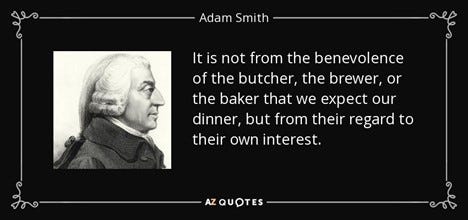Could Trump Stop the Energy Transition?
Is climate a social movement? Or a disruptive technological and economic transition?
Let’s all join invisible and visible hands for climate!
I awoke to the news that Donald Trump was inviting oil company executives to Mar a Lago. He reportedly asked them to donate $1 billion to his campaign in exchange for stopping the transition from ICEs (internal combustion engines) to EVs (electric vehicles).
Climate hawks react differently to this news depending on whether they see themselves as part of a social movement or as a witness to a market-driven industrial transformation. Of course, each viewpoint captures a piece of reality. Yet each camp ignores the wisdom of the other.
Camp #1. Climate hawks who see themselves as part of a social movement controlled by The Visible Hand of public policy (e.g., Sunrise, Bill McKibben) have their hair on fire (to DJT’s delight). They fear that Trumpian policies really could halt the transition to EVs.
In his Earth Day video, Bill McKibben likened the push for climate solutions to earlier social movements, like the protests to end the war in Vietnam and the demonstrations for civil rights and women’s rights.
Protestors in these movements sought to change public policy. Demonstrations were directed at political actors: presidents, legislators, courts— people with the power to advance these movements through the visible hand of policy.
But with climate there is another force at play.
Camp #2. Climate hawks that are techno-optimists have their eyes on the industrial transition from fossil fuels to a clean energy economy. They may barely blink at Trump’s threat to withdraw policy support for EVs. To them The Invisible Hand of the markets (economist Adam Smith) has already advanced the EV transition to a point of inevitability-- or at least a point where smart money is betting on it.
They see the energy transition proceeding along innovation S-curves and cost curves that have been proven throughout history. (see Exit Strategies for O&G Companies)
They focus on the remorseless workings of capitalism’s “creative destruction” whereby old economic regimes die and new ones arise (economist, Joseph Schumpeter).
Greg Jackson, founder and CEO of renewable energy company, Octopus Energy gives voice to this perspective in a recent interview:
“Look at the cost curves for solar and wind and all the other technologies…Honestly, it’s going to be cheaper to stop burning stuff. “
And then Mr. Jackson has an “amazing moment”. He realizes “we didn’t have to arrange the forces for saving the planet against the force of economics, because they actually lined up.”
So how might we best capitalize on this alignment? Use the combined forces of both the invisible hand of the market AND the visible hand of public policy to accelerate the transition to a low carbon economy?
Consultancy Wood Mackenzie provides a roadmap in their approach to the negative impact of higher interest rates on the energy transition. Their solution to this “market headwind” draws on the wisdom of both the invisible and visible hands. It goes like this:
1. Begin with market forces and focus on what may be slowing or stalling them, like the higher interest headwind. Wood Mackenzie points out that start-up capital intensive ventures, like offshore wind farms, are more sensitive to higher interest rates than legacy O&G companies who have paid down their debt during recent years of windfall profits.
“Highly capital intensive and often reliant on subsidies, low-carbon energy and nascent green technologies are most exposed. Debt accounts for a higher share of the capital structure for low-carbon energy sectors….”
In contrast, the oil and gas industry, while also highly capital intensive, has far less exposure to the cost of debt, so is less affected by higher rates.” (April 2024)
2. Design policy to offset this headwind to market forces.
Mackenzie suggests three policies that could mitigate the headwind of high interest rates: 1) Remove obstacles to green energy such as slow permitting. 2) Strengthen carbon markets. 3) Mobilize private finance of green projects.
A President Trump could monkey with the visible hand of policy, opening drilling leases and permitting new LNG facilities. His policies would influence but not control the invisible hand of the market. Falling demand for oil would curb the appetite of O&G companies for new drilling no matter what the presidential policy.





